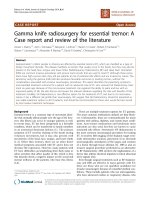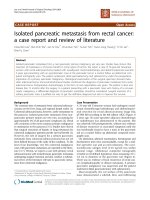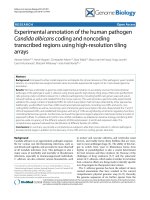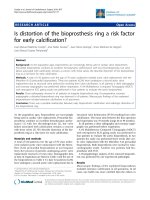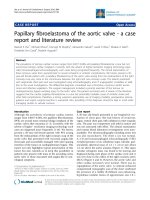Báo cáo y học: "Papillary fibroelastoma of the aortic valve - a case report and literature review" pptx
Bạn đang xem bản rút gọn của tài liệu. Xem và tải ngay bản đầy đủ của tài liệu tại đây (1.94 MB, 5 trang )
CASE REPO R T Open Access
Papillary fibroelastoma of the aortic valve - a case
report and literature review
Neerod K Jha
1*
, Michael Khouri
2
, Donogh M Murphy
3
, Alessandro Salustri
2
, Javed A Khan
1
, Moataz A Saleh
1
,
Friederike Von Canal
4
, Norbert Augustin
1
Abstract
The prevalence of primary cardiac tumour ranges from 0.0017-0.28% and papillary fibroelastoma is rare but not
uncommon benign cardiac neoplasm. Currently, with the advent of higher-resolution imaging technology espe-
cially transoesophageal echocardiography such cases being recogni zed frequently. The clinical presentation of
these tumours varies from asymptomatic to severe ischaemic or embolic complications. We herein, present a 50-
year-old female patient with a papillary fibroelastoma of the aortic valve arising from the endocardium of the right
coronary cusp very close to the commissure between the right and non-coronary cusps. The patient presented
with angina-like chest pain and was inves tigated using echocardiography and CT angiographic modalities in addi-
tion to the usual investigations. The differential diagnosis considered was a thrombus, myxoma, Lambl’s excres-
cence and infective vegetation. The surgical management included a prompt resection of the tumour on
cardiopulmonary bypass avoiding injury to the aortic valve. The patient recovered well. A review of the literature
suggests that the cardiac papillary fibroelastoma is a rare but potentially treatable cause of embolic stroke and
other fatal complications, therefore, a strong suspicion; appropriate use of imaging modality, preoperative anticoa-
gulation and urgent surgical resection is warranted. Also, possibility of this diagnosis should be kept in mind while
managing cardiac or valvular tumours.
Introduction
Although the prevalence of primary cardiac tumors
ranges from 0.0017-0.28%, the papillary fibroe lastomas
(PFE) are second most common benign neoplasm of the
cardiac valves after myxomas [1-3]. Currently, w ith the
advent of higher- reso lution imaging technology such
cases are diagnosed more frequently [1-14]. We herein,
present a 50-year-old female patient with PFE arising
from the endocardium of the right coronary cusp of the
aortic valve that presented with recurrent angina-like
chest pain and successfully managed with valve-sparing
resection of the tumor on cardiopulmonary bypass. This
report not only highlights typical presentation of this
tumor but also reminds us to keep this possibility in
patients who present with ma ss in the ascending aorta,
aort ic valve or those associated with angina-like or neu-
rological symptoms.
Case report
A 50-year-old female presented t o our hospital for eva-
luation of chest pain. She had history of recurrent,
vague, central chest pain with radiation to inter-scapular
area. The pain was compressive and mild in nature and
was not associated with effort. The clinical examination
and routine blood laboratory investigations were unre-
markable. The electrocardiography including stress test
was also inconclusive. The chest x ray was normal.
A 2-D and transoesophageal echocardiography (TEE)
revealed presence of an echodense supra valvular, ped-
unculated, spherical mass of 1.2 × 1 cm in size about
1.2 cm above the aortic annulus (Figure 1). This supra
valvular echogenic mass was found to be moving and
displaced during each phase of the cardiac cycle and it
was very close to the orifice of the right coronary artery
(RCA) (Figure 2 and 3). However, the aortic valve and
other cardiac structures were normal. There was no
regurgitation of the aortic valve. A contrast-enhanced
computerized tomography scan of the chest confirmed
the presence of a mildly ill-defined, non-enhancing,
hypodense nodular lesion of approximate size 1.0 ×
* Correspondence:
1
Division of Adult Cardiac Surgery, Institute of Cardiac Sciences, Sheikh
Khalifa Medical City (Managed by Cleveland Clinic), PO Box-51900, Abu
Dhabi-UAE
Full list of author information is available at the end of the article
Jha et al. Journal of Cardiothoracic Surgery 2010, 5:84
/>© 2010 Jha et al; licens ee BioMed Central Ltd. This is an Open Access article distributed under the terms of the Creative Comm ons
Attribution License (http://crea tivecommons.org/licenses/by/2.0), which permits unrestricted use, distribution, and reproduction in
any medium, provided the original work is properly cited.
0.8 × 0.7 cm in the aortic root, just adjacent to the ori-
gin of right coronary artery (Figure 4). Based upon the
findings as above, a differential diagnosis was made
which included, thrombus, myxom a, fibroelastoma and
inflammatory mass.
In view of the possibility of embolism and unknown
nature of the pathology, the patient was taken for urgent
surgical resection under standard cardiopulmonary
bypass at systemic hypothermia (32 degree Celsius) and
systemic heparinisation. The ascending aortic and right
atrial cannulation was done before institution of cardio-
pulmonary bypass. The aortic cross clamp was applied
and heart was arrested using antegrade blood cardiople-
giaviatheroot.Subsequently,atransverseaortotomy
was performed proximal to the aortic root . On explora-
tion a 1 × 1 cm pedunculated tumor mass was found to
be attached to the right coronary cusp very close to the
commissure between the right and non-coronary cusp
of the aortic valve. The tumor mass was firm, glistening,
friable and looked filamentous on gross examination
(Figure 5). The aortic valve was tri-leaflet and structu-
rally and functionally found to be normal. A complete
resection of the tumor was achieved which was con-
firmed by postoperative TEE (Figure 6). The aortic valve
was found to be competent and functionally well with-
out any residual defect or perforation after the proce-
dure. The patient had an uneventful weaning from the
cardiopulmonary bypass and recovered well in the
immediate post operative period.
Histopathology examination of the resected tumor
revealed a papillary proliferation including few fibro-
blasts, collagen and elastic fibers, covered with
Figure 1 Trans-oesophageal echocardiography showing a
mobile, spherical pedunculated tumour mass of 1.2 × 1 cm in
size at the right coronary aortic cusp (ME AV short-axis view).
Figure 2 Trans-oesophageal echoca rdiography showing supra
valvular tumour during diastole near the right coronary artery
(RCA) ostium (ME AV long-axis view).
Figure 3 Trans-oesophageal echoca rdiography showing supra
valvular tumour during early systole moving away from the
right coronary artery (RCA) ostium (ME AV long-axis view).
Figure 4 Contrast computerized tomography image showing a
filling-defect (tumour) attached to the aortic valve near the
origin of the right coronary artery (RCA).
Jha et al. Journal of Cardiothoracic Surgery 2010, 5:84
/>Page 2 of 5
hyperplastic endothelial cells. These features confirmed
the diagnosis of papillary fibroelastoma (Figure 7). The
postoperative course was uneventful and the patient was
discharged in a satisfactory condition on 7
th
day.
Discussion
Cardiac papillary fibroelastomas are classified as primary
benign endocardial tumours arising from the normal
component of the endocardium like fibr ous tissue, elas-
tic fibers or smooth muscle cells. Characteristically they
have a short pedicle and multiple papillary fronds simi-
lar to a sea anemone [1]. They often (85%) originate
from the valvular endocardium. The aortic valve (29%),
mitral valve (25%), tricuspid valve (17%) and pulmonary
valves (13%) are involved in that order [1]. However,
PFE arising from semilunarvalvesarelocatedwith
equal frequencies on the ventricular and arterial sides of
the valves. In addition, non-valvular origin was observed
in approximately 16% cases thatincludedleftandright
ventricular septal and mural endocardial surfaces, atrial
endocardium, papillary muscles, chordae tendinae or
intima of the right coronary ostium [1-10]. In addition,
multifocal “tepete” (carpet-like) PFE of the left ventricu-
lar cavity has also been reported [2].
The origin of PFE is unclear and various possible
causes have been mentioned in the literature. They have
been considered as hamartomas, organized thrombi,
iatrogenic (post radiation, surgery) or inflammatory foci
due to unusual endocardial responses to infection or
hemodynamic trauma [3].However,someauthors
believe that PFE’s are true neoplasms [1-3].
Clinical presentation of PFE’svariesfromasympto-
matic to severe thromboembolic complications, myocar-
dial ischemia, infarction and stroke. However,
pulmonary embolism, congestive heart failure, near-
syncope, ventricular fibrillation and sudden death have
also been reported [1-10]. Embolisation may occur from
fragments of the fronds of the tumour or from a throm-
bus that frequently forms on the tumour ‘nidus’ due to
platelet or fibrin aggregates.
In our patient, the atypical vague chest discomfort and
pain could hav e been due to the partial, intermittent
obstruction or limitation of blood flow thro ugh the r ight
coronary artery orifice in the aortic root due to the strategic
location and variable mobility of the tumour mass during
various phases of cardiac cycle (Figure 2 and 3). Therefore,
this could be considered as angina-like symptom.
Thediagnosisisusuallymadeby2-dimentionalor
transoesophageal echocardiography. Recently, 3-D echo-
cardiography, magnetic resonance imaging and multi-
slice spiral c omputed tomography have also been used
Figure 5 Gross specimen of resected mass.
Figure 6 Postoperative trans-oesophageal echocardiography
confirming complete resection of the tumour and normal
aortic valve (ME AV long-axis view).
Figure 7 Histological section of the excised mass showing
benign papillary lesion comprised of a single layer of
endocardial cells overlies a thin layer of mucopolysaccharide
matrix and underlying, almost acellular, avascular stroma
composed predominantly of elastic fibers and a small amount
of collagen. (Hematoxylin and Eosin stain, magnification × 40).
Jha et al. Journal of Cardiothoracic Surgery 2010, 5:84
/>Page 3 of 5
for better delineation of similar tumors [6,8]. Typical
echocardiographic features include a small (1-4 cm),
highly mobile mass with a pedicle attached to the valve
or endocardial surface and a frond-like appearanc e with
or without multifocal involvement. The contrast CT
image typically shows a filling defect in the aortic root
adjacent to the origin of coronary artery [6].
Despite the benign nature of this tumour, it carries
very high risk of embolic complications including neuro-
logical deficit. The fragile nature and frond-like papillary
tissues of the tumour itself is prone to thromboembo-
lism [1-7]. Therefore, once diagnosed, urgent surgical
management is indicated evenintheasymptomatic
patients [1,4,5,7,10]. The management of such tumours
also includes early anticoagulation. The surgical man-
agement requires extracorporeal circulation and an aor-
totomy which is similar to that used in typical aortic
valve replacement procedures. The PFE ’s are usually
pedunculated and may be easily removed with asso-
ciated endocardial tissue. Care should be taken to avoid
fragmentation of the tumour tissue. Also, aortic valve
should be preserved preferably. In case, if th ere is resul-
tant valve defect, it should be repaired, otherwise a valve
replacement is warranted. The surgical resection is cura-
tive, safe and well tolerated [5,7,9,10]. Intraoperative
TEE is essential to assess valvular function after tumour
resection. Re-growth of the tumour after resection has
notbeenreported,anditrequireslong-termTEE
follow-up studies to confirm.
Law ‘et al’ have done a review of the English language
literature using ‘Pub Med’ (US National Library of Med-
icine) to identify previously published cases of PFE from
1997 up to 2008 [2,7]. They found 833 cases published
so far with a male preponderance (58%) and mean age
of 56 years. The tumour size ranged from 2 to 70 mm.
The two most preferred locations were aortic (4 4-52%)
and mitral valve (35-40%). In majority of the cases echo-
cardiography was the imaging m odality (98%) a nd exci-
sion of the tumour (79%) as preferred treatment. We
have tried to update the review of literature including
recently published reports (Table 1).
Conclusion
Cardiac PFE’s are not uncommon tumours and s hould
be considered in the differential diagnosis of cardiac
masses. A strong suspicion, appropriate use of imaging
modality, pre operative anticoagulation and urgent
resection of the tumour is not only life saving but also
avoids tumour-related vascular, embolic or neurological
complications.
Table 1 Previously reported cases of cardiac papillary fibroelastoma
Reference Number of patient Mean age (yr) Sex distribution Size (mm) Site Presentation Management
Grinda ‘et al’
1
(1999)
04 54 3 Males
1 Female
10 1 MV
1TV
1AV
CVA
Aphasia
Syncope
TIA
Excision+MVR
Excision+TVR
Excision+AVRp
Excision
Saw ‘et al’
14
(2001)
03 45 2 Females 6-7 1 IVS
2MV
Stroke
Abdominal pain, VSD
Excision
Darvishian ‘et al’
7
(2001)
02 50 1 Male 10-15 2 MV Dyspnea
Ataxia
Dysphasia
Mitral
Repair+ excision
Gowda ‘et al’
13
(2003)
725 70 56% Males 2-70 44% AV
35% MV
32% Stroke
13% Angina
81% Excision
10% AVR
Sato ‘et al’
9
(2003)
01 74 Male 9 LVOT AF
Chest discomfort
Excision
Ngaage ‘et al’
12
(2005)
88 62 71% Males - 52% AV
18%- LVOT
52% -Dyspnea
32% TE
83% excision
Kumbala ‘et al’
11
(2008)
01 60 Male 9 AV TIA Excision
Law’ et al’
2
(2009)
01 25 Male 9 LVOT (multiple) Stroke Excision+MVRp
Bicer ‘et al’
3
(2009)
01 72 Male 12 LA Stroke Excision
Parthenakis ‘et al’
8
(2009)
01 29 Female 12 AV Asymptomatic Excision
Domenech ‘et al’
4
(2010)
01 59 Female 11 LV Stroke Resection
AV-aortic valve, IVS-interventricular septum, MV-mitral valve, CVA-cerebrovascular accident, TIA-transient ischemic attack, VSD-ventricular septal defect, AF- atrial
fibrillation, LVOT-left ventricular outflow tract, LA- left atrium, LV- left ventricle, MVR-mitral valve repair, TVR-tricuspid valve repair, AVRp-aortic valve replacement,
MVRp-mitral valve replacement, AVR-aortic valve repair.
Jha et al. Journal of Cardiothoracic Surgery 2010, 5:84
/>Page 4 of 5
Consent
Written informed consent was obtained from the patient
for publication of this case report and any accompany-
ing image. A copy of the written consent is available for
review by the Editor-in-Chief of this journal.
Author details
1
Division of Adult Cardiac Surgery, Institute of Cardiac Sciences, Sheikh
Khalifa Medical City (Managed by Cleveland Clinic), PO Box-51900, Abu
Dhabi-UAE.
2
Division of Cardiology, Institute of Cardiac Sciences, Sheikh
Khalifa Medical City (Managed by Cleveland Clinic), PO Box-51900, Abu
Dhabi-UAE.
3
Department of Laboratory Medicine, Sheikh Khalifa Medical City,
(Managed by Cleveland Clinic), PO Box-51900, Abu Dhabi-UAE.
4
Department
of Anaesthesiology, Sheikh Khalifa Medical City, (Managed by Cleveland
Clinic), PO Box-51900, Abu Dhabi-UAE.
Authors’ contributions
All authors have contributed in case management, manuscript preparation
and image acquisition.
Competing interests
The authors declare that they have no competing interests.
Received: 9 June 2010 Accepted: 17 October 2010
Published: 17 October 2010
References
1. Grinda JM, Couetil JP, Chauvaud S, D’Attellis N, Berrebi A, Fabiani JN,
Deloche A, Carpentier A: Cardiac valve papillary fibroelastoma: surgical
excision for revealed or potential embolization. J Thorac Cardiovasc Surg
1999, 117:106-10.
2. Law KB, Phillips KRB, Cusimano RJ, Butany J: Multifocal “tapete” papillary
fibroelastoma. J Clin Pathol 2009, 62:1066-1070.
3. Bicer M, Cikirikcioglu M, Pektok E, Muller H, Dettwiler S, Kalangos A:
Papillary fibroelastoma of the left atrial wall: a case report. Journal of
Cardiothoracic Surgery 2009, 4:28.
4. Domenech A, Arenaza DP, Rivello HG, Patrucco L, Bracco D: Surgery for
papillary fibroelstoma with uncommon location in left ventricle. Asian
Cardiovasc Thorac Ann 2010, 18:174-6.
5. Boodhwani M, Veinot JP, Hendry PJ: Surgical approach to cardiac papillary
fibroelsatomas. Can J Cardiol 2007, 23(4):301-302.
6. Chia PL: Incidental finding of an aortic valve mass on 64-slice computed
tomographic coronary angiography. Annals Academy of Medicine 2009,
38(10):926-927.
7. Darvishian F, Farmer P: Papillary fibroelstoma of the heart: report of two
cases and review of the literature. Annals of Clinical & Laboratory Science
2001, 31(3):291-296.
8. Parthenakis F, Nyktari E, Patrianakos A, Pitsis A, Asimaki A, Vardas P:
Asymptomatic papillary fibroelastoma of the aortic valve in a young
woman-a case report. Cardiovascular Ultrasound 2009, 7:43.
9. Sato Y, Yokoyama H, Satokawa H, Takase S, Maruyama Y: A report of a
surgical case of papillary fibroelastoma in the left ventricular outflow
tract. Ann Thorac Cardiovasc Surg 2003, 9(4):270-273.
10. Gopaldas RR, Atluri PV, Blaustein AS, Bakaeen FG, Huh J, Chu D: Papillary
fibroelastoma of the aortic valve-operative approaches upon incidental
discovery. Tex Heart Inst J 2009, 36(2):160-163.
11. Kumbala D, Sharp T, Kamalesh M: “Perilous Pearl” papillary fibroelastoma
of aortic valve: a case report and literature review. Angiology 2008,
59(5):625-628.
12. Ngaage DL, Mullany CJ, Daly RC, Dearani JA, Edwards WD, Tazelaar HD,
Mcgregor CGA, et al: Surgical treatment of cardiac papillary
fibroelastoma: a single center experience with eighty-eight patients. Ann
Thorac Surg 2005, 80:712-18.
13. Gowda RM, Khan IA, Nair CK, Mehta NJ, Vasavada BG, Sacchi TJ: Cardiac
papillary fibroelastoma: a comprehensive analysis of 725 cases.
Am Heart
J 2003, 146:404-10.
14. Saw W, Nicholls S, Trim G, Thomson D, Hughes C, Mitchell S, Leitch J:
Papillary fibroelastoma, a rare but potentially treatable cause of embolic
stroke: report of three cases. Heart, Lung and Circulation 2001, 10(2):105-7.
doi:10.1186/1749-8090-5-84
Cite this article as: Jha et al.: Papillary fibroelastoma of the aortic valve
- a case report and literature review. Journal of Cardiothoracic Surgery
2010 5:84.
Submit your next manuscript to BioMed Central
and take full advantage of:
• Convenient online submission
• Thorough peer review
• No space constraints or color figure charges
• Immediate publication on acceptance
• Inclusion in PubMed, CAS, Scopus and Google Scholar
• Research which is freely available for redistribution
Submit your manuscript at
www.biomedcentral.com/submit
Jha et al. Journal of Cardiothoracic Surgery 2010, 5:84
/>Page 5 of 5
